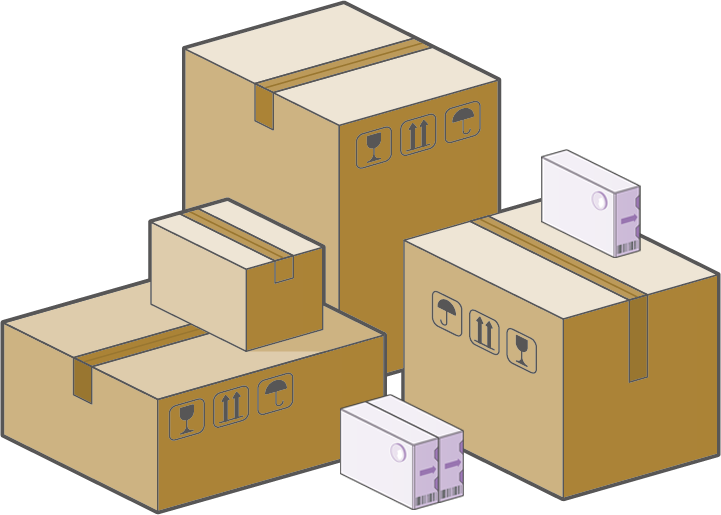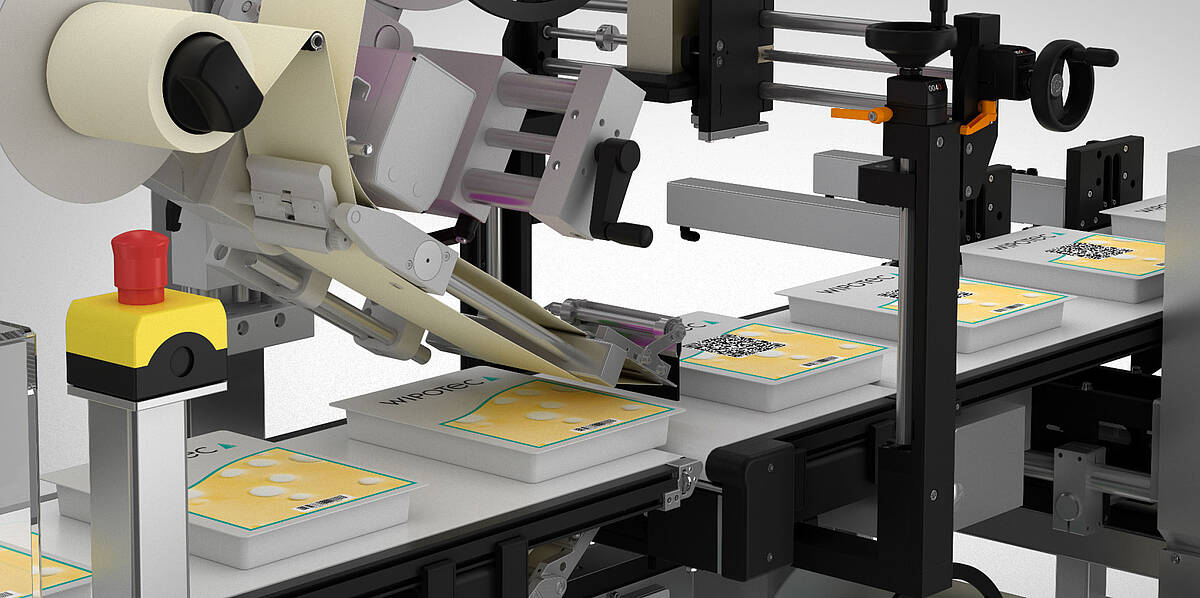Marking with TQS: more than labeling!
Packaging comes in a wide range of shapes and sizes and yet it still has to be labeled for retail sector according to applicable regulations. In this respect, different industries often place fundamentally different requirements. This starts with the application of preprinted design labels on the flat thermoform packages used in the food industry, serialized labels on the top and bottom of trays of medical products and sealings for folding boxes containing pharmaceuticals – directly covering the corner at the tabs with tamper-evident labels. At the same time, medications in vials or cans are labeled all-round, as are the glass bottles of high-quality spirits, for example.
In modern production facilities, an efficient system for labeling with the ability to mark with text and code is therefore essential. End-of-line printing makes it possible to encode specific batch information or to apply a serial number in the context of complete serialization. Accordingly, verification of these data must not be omitted. Immediate inspection of labels protects products with correct content from being rejected, reduces waste and thus saves on costs. Prioritize efficiency.
The main disciplines
As different as packaging types may be, all products must bear legible markings. The size, content and position of a label thus depend explicitly on the application in question. Some industries, such as the pharmaceutical industry, regulate these requirements through specific legal regulations. In many countries around the world, medicines must carry serialized labels and their code must meet the strictest quality requirements in accordance with the pharmaceutical falsification directive. In other areas, the market sets the conditions. When major retail chains require certain markings, manufacturers must include them in order to be listed at all.
A suitable system should therefore be able to process as wide a variety of packaging types as possible.
Labeling flat products
Perishable goods such as sliced cheese or cold cuts require special care during production. Securely packaged in thermoform packages or film, the products must not only be accurately weighed and checked for foreign objects using a metal detector, but also labeled at the top and bottom. The TQS unit presented meets these requirements. It has two labeling units which apply labels and check the result directly – whereby in this case only the lower unit prints dynamically beforehand.
Our customers appreciate the system’s modularity, thanks to which suitable labelers are easily integrated into any system. Even if other functions are added, the processes remain fully automatic. So your processes do not become more complicated the more modules you add, but rather on the contrary – the central control system where everything comes together proves to be a significant advantage over individual units for printing, labeling, verifying, weighing, inspecting, transporting and rejecting.
Checking the label content does not require teach-in. The layout with the initial setup of the item is stored in the system, so product changes are effortless and the camera module automatically knows how the text or code should appear. This solution is also recommended for other formats with flat surfaces, such as the typical cartons.
Corner labeling
There can be various reasons for applying a label over edges, where the dimensions of the product often play a decisive role:
- Employees can check printed information on large shipping boxes much more easily if it is visible from two sides, for example on a shelf or on a pallet. For this purpose, a large label is printed with two sets of information. The label is applied across the corner so that the same information is visible on both sides.
- If, however, medicines are packed in small folding boxes, there are specific regulations that require a tamper-evident seal on the packaging to protect the consumer. Tamper-evident labels are thus standard practice in the pharmaceutical industry, and are also used as tamper protection for high-quality cosmetics, spirits and foodstuffs.
Corner labeling succeeds with a version of the TQS-HC-A that fully integrates a module for applying tamper-evident labels. One system prints, weighs, labels and inspects your products automatically.
All-round labeling
For goods transported upright in bottles or vials, label application must be especially accurate, as the label is usually applied all-round. Our TQS solutions apply your markings reliably without any misalignment. Depending on the size of the packaging, different technologies are used to ensure optimum product handling and thus a steady flow of goods.
In addition to cylindrical objects, our system also easily accepts square bottles or other angular formats. In the video, we demonstrate how our ConfigureFast mode helps with product change. The operator can easily make all the required settings via the intuitive user interface. All the information from the printer, camera, checkweigher and labeling module is controlled and monitored via a central display.
For safety’s sake, the system also checks each marking for errors before the label is affixed to the container. The system detects labels that do not meet the prescribed quality standards and rejects them before they are applied to the product. This saves you time-consuming rectification work. But that is only a fraction of what TQS can do for your business. Our solutions also combine numerous functions in a very small space, freeing up valuable space on the production floor.
The art of marking
A product must provide a wide range of data: weight, ingredients, nutritional information, expiry date, barcode and many more. This information is featured on the label of many packaging forms. Some things can be pre-printed in the design, but batch- and production-specific data can only be marked up in the line. 2D codes will soon assume the majority of these functions so that both customers and cashiers simply need to scan the code on the label to obtain all the contents. The prerequisite for this, however, is that labels are printed and applied flawlessly.
Preprinted labels
TQS handles the application of seals and design labels with equal ease. In addition, the system checks their presence, position and orientation on the product, whether the label is damaged or has creases – and even its contents! Especially in the case of extensive prints such as the labels on shrink-wrapped foodstuffs, this inspection can only be carried out in an automated process.
Sealing of pharmaceutical products with tamper-evident labels is also verified in this way. The complete inspection is fully integrated into the system, and is thus centrally controllable and traceable. The system character of TQS once again proves to be a decisive advantage here.
Printing labels in-line
Two labeling units form part of this modular system: While the upper module applies pre-produced labels, the lower unit’s system prints additional markings on the labels and applies them to the underside. These contain product-specific data as text or, for example, batch codes. Of course, the modular system structure also offers the possibility to use these functions as you wish.
Alternatively, anything that can be printed as text can be packed extremely compactly in the form of a code that provides the right information to all contact points in the supply chain. This makes your production more transparent and simplifies identification of your products. Innovative 2D codes with variable data are already on the point of being launched and are slowly but surely being introduced in the retail sector.
Finally, in the production process, camera modules check the labels on the top and bottom of the product. They not only verify that the content is correct and that the quality requirements are fulfilled, so that the code can be scanned later at the checkout or with a mobile device without any problems. The system also checks the presence of the label and whether it has been applied without any errors within the specified tolerances. Such extensive control is so user-friendly that it remains practicable in everyday production, thanks solely to the TQS central control system.
Security through serialized labels
In the pharmaceutical industry, a whole set of global regulations govern the scope and process of serialization in detail. Increasingly, manufacturers of cosmetic products and foodstuffs are also taking an interest in the individual labeling of their products. However, since no legal regulations exist in these industries yet, the motivation for using this is different: to protect consumers and the dedicated brand from counterfeiting and to ensure the traceability of goods throughout the supply chain.
Baby food in particular, whose comparatively expensive ingredients combined with consistently high demand make it a popular target for fraud, benefits greatly from full serialization. Our expert webcast provides information about its detailed implementation in practice and presents various solutions.
Do you want to label pharmaceuticals, foodstuffs or other consumer goods in vials, cans, trays, bags, cartons or vials? We explain what is important here and the key role that modularity plays.



